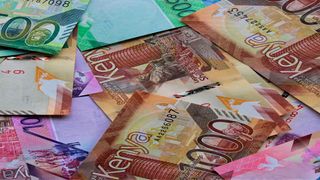
Kenyan currency notes.
| ShutterstockFinance and Markets
Premium
Free fall? Shilling breaches 150 mark against the dollar
What you need to know:
- Since the beginning of the year, the shilling has depreciated by 17.7 per cent against the dollar.
- The weaker shilling against the dollar has meant costlier purchases for importers and merchant traders.
The official exchange rate of the shilling against the dollar on Monday crossed the 150-unit mark following a period of sustained and consistent depreciation that has narrowed the gap between the official and retail selling rates of the US currency.
Since the beginning of the year, the shilling has depreciated by 17.7 per cent against the dollar, which is more than double the 8.3 per cent it shed against the unit in the whole of 2022.
The Central Bank of Kenya (CBK) indicative rate published on Monday morning showed the dollar’s buy price at Sh149.84 and a selling rate of Sh150.04 units, hence an average of 149.94.
The spot or average trading rate had climbed to Sh150.03 in the afternoon.
The indicative rate is the closing price of the previous day’s trading session, which is taken as the opening price of the following day.
A check in banking halls of 12 commercial lenders — including all nine tier one banks — showed that they were selling the dollar at between Sh154.95 and Sh157, and buying at a range of Sh141 and Sh149.95.
Forex bureaus, meanwhile, quoted dollar selling prices of between Sh156.50 and Sh157 while buying at between Sh152 and Sh153.
Banks have been selling dollars above the Sh150 level from late August. A forex dealer told the ‘Nation’ that the lenders are seeing resistance on the sell side at around Sh156, signalling the currency might be finding its true rate after months of consistent depreciation.
The reopening of the interbank dollar market from April and removal of a Central Bank of Kenya (CBK) rule that capped daily deviation from the indicative rate at 20 cents has helped the exchange rate find its own level through demand and supply.
“The interbank market is better than where we were in March, even though there are still a few structural issues to sort out. Overall, we have seen the spread between retail and official selling price of the dollar come down to between Sh4 and Sh6, from double digits in the first quarter,” said a dealer.
During the period, the interbank market was not functioning, banks quoted the rate at which they were buying the dollar in line with that of the CBK rate to avoid regulatory reprimand, but on the sell side they were charging each other — and customers— a margin of up to Sh13 above the official rate.
Treasury Cabinet Secretary Njuguna Ndung’u, when appearing before the National Assembly on September 27, said the shilling’s recent slide was not a free fall, but rather a “process of adjustment” from what he termed as historical policy mistakes in management of the shilling.
Prof Ndung’u said Kenya had largely held its currency constant in the previous five to seven years even as the country’s price structure changed, leaving it misaligned with the real economy.
“We are actually paying the price of misalignment which happened in the previous five to seven years,” said the CS when he appeared before Parliament to answer questions from MPs.
“As soon as we allowed the nominal exchange rate to move — because there was a requirement that it can’t fluctuate more than 20 cents either way — then we restarted the interbank market, there was [a] steep depreciation which was also being pushed by scarcity of dollars.”
In comparison to other regional currencies, the shilling loss against the dollar this year stands out.
The Uganda shilling, for instance, has depreciated by 0.96 per cent to the greenback since January, while the Tanzania unit has shed 6.8 per cent while the Rwandan franc has appreciated by 14 per cent to the US currency since the turn of the year.
This year, the Uganda shilling has gained 20.2 per cent to exchange at 25.04 units versus the Kenyan unit while the Tanzania shilling gained by 13.4 per cent to 16.67 units as the Rwandan franc rose 6.1 per cent to 8.15 units.
The weaker shilling against the dollar has meant costlier purchases for importers and merchant traders while the external debt load has grown on a local currency perspective. Exporters have, on the other hand, enjoyed exchange gains when they are paid in the US currency.





